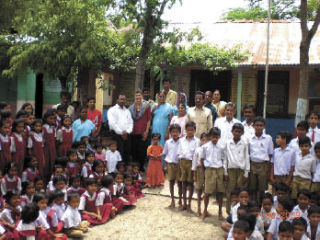Four years after hosting a teacher from India in her classroom at Islander Middle School, it was Vicky Mann’s turn to visit schools and collaborate with teachers in Akola, India.
“I was absolutely eager to go,” said Mann, 54. “I love teaching. The chance to go to another country and work with other teachers was extremely enticing.”
Mann, who has taught for 25 years, spent nine days in Akola at the end of July with a team of four other local teachers — the Vishal Himalaya Foundation’s “first attempt at a teacher workshop,” said the foundation’s co-executive director, Eva Agrawal, who established the nonprofit in 1999 with her husband, Yogi Agrawal.
The workshop was held in Vishal Himalaya’s India Teachers Center, which serves as a place where educators can network with each other, receive instruction and training, and access computers and the Internet.
Assigned to a group of 21 teachers, Mann initially intended to present a culture project that had been completed by her seventh-grade class — a project of researching family history. But that plan, she found, would have to change.
“When I got down there and met the teachers, and saw and heard what their issues were and what they wanted, it didn’t seem to fit very well,” Mann said. Instead, she introduced strategies for teaching social studies, “teaching to students’ strengths,” exploring different methods for learning and studying, the concept of working in small groups, and even illustrating lines of poetry.
“I wanted to give them something they could use in their classrooms,” she said; classrooms in government schools, village schools, private schools.
Students wear uniforms in all schools, and languages range from English to Molotti to Hindi. They often ride their bicycles to school, as Mann found when she would walk the streets of Akola — unpaved, filled with shopkeepers’ booths, wandered by cows, buffalo and pigs — and a group of kids would stop to chat, as they were curious about foreigners and wanting to practice their English.
A typical class in a government school could have as many as 120 students.
“It was daunting to me, it was amazing how many students they have in a classroom,” said Mann. “They’re just jammed — kids sitting three to a desk, if they had desks; if not, they’re sitting on the floor.”
Public classrooms, which lack electricity, are primitive — dark, with dirt floors and peeling wall paint. Most private schools are affiliated with the Catholic church, Mann observed, and have smaller class sizes.
They “were beautiful,” she said, “like schools on Mercer Island, with gardens, and computer labs.”
As for the village schools, Mann said her team expected they would be the poorest, but found the opposite. “We’d find these beautiful little schools in the middle of the fields, and the teachers who were there had put in all this effort to make these schools places where kids wanted to go.”
Yet, ultimately, a classroom’s conditions, whether poor or well-to-do, didn’t matter in the passion for education, Mann noted.
“It’s incredible what the teachers are doing in those schools because they were just so awesome and so eager and happy to be there, and the kids, they understood how important it was for them to be at school even if the conditions were nothing like we expect,” Mann said.
“You could tell it didn’t matter if you were sitting in a dirt floor classroom. You could tell they really valued their education, and they valued their teachers … We were so excited and inspired by the teachers that we met because they really — like the teachers up here — wanted their students to have a better life, to be successful. They wanted to see their students succeed, and they would do whatever they could to make that happen.”
By the end of the nine days, Mann found that not even her visit to the Taj Mahal and various temples and mosques could compare with the people who she met.
“That’s really what we’re going to remember,” she said. “And the fact that it was such little things that could make such a big difference there, just showing the teachers one small little strategy for helping a kid study, teaching them how to make up a song, about something they learned in history or making up a rhyme — those are things they had never thought of, and it would instantly transform the classroom … The fact that we could do something and that we did have something to offer was extremely rewarding for us. It wasn’t just us giving to them — their attitudes and their devotion was really inspiring to me. I think I probably got a lot more out of the visit than they did from me.”



